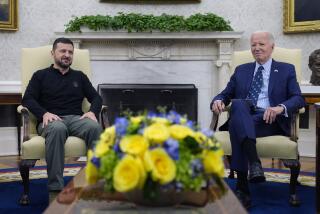Clinton Offers $19.5-Billion Package to Help Defense Industry After Cuts : Pentagon: Expansion of high-technology jobs is the primary goal. Little immediate relief is proposed for displaced workers or affected firms.
LINTHICUM, Md. — President Clinton unveiled a $19.5-billion long-range plan Thursday to help the defense industry adjust to cutbacks in the military budget, saying it would help the economy bounce back and bring “a new century of strength, growth and opportunity.”
As expected, however, the program would provide little immediate relief for laid-off defense workers and firms affected by cuts and base closings.
Under the plan, Clinton will release $1.4 billion in unspent defense conversion funds approved by Congress last year and rechannel another $300 million from other programs. But only a fraction of that money will be used for worker retraining.
Instead, the White House plans to contend with the defense conversion problem mainly by seeking to foster the expansion of high-technology jobs in future years--proposing that $19.5 billion in grants be spent between now and fiscal 1997 to help defense industry firms develop new technology and manufacture products that can be sold commercially.
Clinton attempted to underscore his concern for the defense industry and its workers by traveling to this suburb of Baltimore to visit the Westinghouse Electronic Systems Group--a defense firm that recently has begun diversifying to manufacture such commercial products as airline radar and home-security equipment.
“What you have done here is what I wish to do nationally--take some of the most talented people in the world who’ve produced some of the most sophisticated military technology and put that to work in the civilian economy,” he told several hundred workers and guests.
The President also announced that, effective immediately, the Defense Advanced Research Products Agency, which previously had provided grants to defense contractors to help finance development of weapons systems, would begin underwriting some commercial research as well.
And he said that beginning today the White House would set up a new toll-free telephone number, 1-800-DUAL-USE, to enable companies to obtain more information about the grant program and to proffer their proposals for federal funding.
Few of the proposals that Clinton described were new. The President announced his plans to release the $1.7 billion in unspent and rechanneled funds during a visit to Santa Monica Feb. 22. He also described most of his proposal for fostering high-tech that same day.
Rather, the thrust behind Thursday’s effort appeared to be political, designed to divert attention from an announcement expected today outlining the Administration’s recommendations for military base closings in 1993.
The base closure list, which reportedly includes installations in California, already has sparked a political firestorm and heavy lobbying by members of Congress. An independent commission has until July 1 to review the recommendations.
Today, while the list is being disclosed, the President will be in Norfolk, Va.--along with Defense Secretary Les Aspin--to visit the aircraft carrier Theodore Roosevelt. Aides say both men are trying to improve their images among military personnel.
Clinton was accompanied to the Westinghouse plant by several of his Cabinet officers and a group of senators and congressmen, including Sens. Dianne Feinstein (D-Calif.) and Barbara Boxer (D-Calif.) and Rep. Jane Harman (D-Marina Del Rey).
A White House summary of the program announced: “In a sweeping policy shift, the Clinton Administration will distribute $1.4 billion that Congress appropriated last year for defense conversion, which the Bush Administration had opposed and declined to spend.”
Clinton told the Westinghouse workers: “You have given us a stunning example of just how brilliantly (defense conversion) can be done here in this fine facility.” And a White House official said the Linthicum plant was “the perfect example” of what Clinton had in mind.
But the company’s viewpoint was somewhat different. Al Spencer, special assistant to the firm’s president, said in an interview that Westinghouse’s diversification effort was accomplished “pretty much on our cuff” without help from the federal government.
And company officials conceded that despite its success in finding new commercial markets, Westinghouse’s Maryland operations still had to lay off about 4,400 workers between 1991 and 1993. The firm employed 17,000 workers at its peak in the 1970s.
The major elements of Clinton’s program include:
* Release of $1.4 billion in unspent defense conversion funds held up during the George Bush Administration and $300 million that Clinton has rechanneled from other programs and from his economic stimulus plan.
The package contains $845 million for grants to underwrite research for “dual use” technology, $637 million to help workers, military personnel and communities hurt by defense cuts, and $185 million for new technology.
* Allocation of about $500 million in Pentagon funds to help industry-led consortiums develop “dual-use” technology that defense firms can use to broaden their bases by manufacturing products that can be sold to military and civilian customers.
* Rechanneling of existing fiscal 1993 monies and funds from the President’s proposed economic stimulus package to provide another $94 million for Energy Department R&D; grants and $117 million in Commerce funds.
The Administration also will propose spending $64 million for pilot projects that demonstrate the benefits of computer networking to schools and libraries. The White House offered no details of what that might involve.
Clinton also said he will propose allocating almost $4 billion over the next four years for worker retraining programs, including $150 million for government- and employer-sponsored projects to help displaced defense workers.
The program also will include $112 million to help members of the National Guard and reserves who are being dropped from the rolls and to provide severance pay and health benefits for civilian Defense Department employees who may be laid off.
And the Pentagon announced Thursday that it would offer early retirement and lifelong benefits to more than 17,000 active-duty troops with between 15 and 20 years of service, allowing them to receive retirement checks and remain eligible for other benefits.
More to Read
Sign up for Essential California
The most important California stories and recommendations in your inbox every morning.
You may occasionally receive promotional content from the Los Angeles Times.










